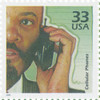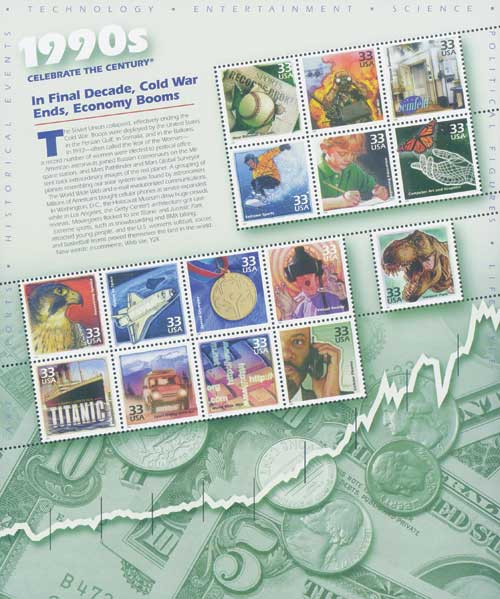
# 3191o - 2000 33c Celebrate the Century - 1990s: Cellular Phones
US #3191o
2000 Cellular Phones – Celebrate the Century (1990s)
• Part of the tenth and final sheet in the Celebrate the Century stamp series issued from 1998-2000
• Commemorates the rise in popularity of cellular phones
• Includes text on the back with historical details
Stamp Category: Commemorative
Series: Celebrate the Century
Value: 33¢ First Class Mail Rate
First Day of Issue: May 2, 2000
First Day City: Escondido, California
Quantity Issued: 82,500,000
Printed by: Ashton Potter (USA) Ltd.
Printing Method: Offset, Intaglio
Format: Panes of 15
Perforations: 11.5
Tagging: Block tagging
Why the stamp was issued: To recall the increased use of cellular phones in the 1990s and their continued influence on communication from then on.
About the stamp design: Pictures artwork by Drew Struzan of a person talking on a cell phone. Includes the following text on the back: “The popularity of cellular phones skyrocketed as the phones became smaller and cheaper, sound quality improved, and service became more widely available. In 1999, more than 78 million Americans had cellular service.”
First Day City: The First Day of Issue Ceremony was held at the Village Amphitheater of San Diego Wild Animal Park in Escondido, California.
About the Celebrate the Century series: The USPS launched the Celebrate the Century series in 1998 to mark the end of the 20th century and herald the arrival of the 21st. The series includes 10 sheets of 15 stamps (150 in total), with each honoring important moments from a different decade (1900s, 10s, 20s, 30s, 40s, 50s, 60s, 70s, 80s, and 90s). At the time of completion, it was the longest and most ambitious commemorative stamp series in US history.
History the stamp represents: The basic idea behind the modern mobile telephone network was proposed in 1947, but it took a long time for technology to catch up with the concept. The broadcast of radio messages over airwaves is controlled by the Federal Communications Commission (FCC), which slowed cellular phone development for many years.
A cell phone is actually a sophisticated two-way radio. In 1947, AT&T asked the FCC to allocate more radio frequencies for mobile telephone service. Providing more frequencies would motivate companies to conduct the needed technological research. The FCC denied the request and limited the frequencies, which at that time allowed just 23 mobile telephone conversations to occur simultaneously in the same service area.
Even though a huge consumer demand for mobile telephones existed, the FCC didn’t reconsider its position until 1968. The number of frequencies was increased, freeing up the airwaves for more mobile phones. In 1982, the FCC authorized commercial cell service in the US.
Cellular telephone use skyrocketed during the 1990s. Mobile telephone technology is becoming more advanced every day. Cellular companies now offer digital service, which provides better call quality than the traditional analog technology.
US #3191o
2000 Cellular Phones – Celebrate the Century (1990s)
• Part of the tenth and final sheet in the Celebrate the Century stamp series issued from 1998-2000
• Commemorates the rise in popularity of cellular phones
• Includes text on the back with historical details
Stamp Category: Commemorative
Series: Celebrate the Century
Value: 33¢ First Class Mail Rate
First Day of Issue: May 2, 2000
First Day City: Escondido, California
Quantity Issued: 82,500,000
Printed by: Ashton Potter (USA) Ltd.
Printing Method: Offset, Intaglio
Format: Panes of 15
Perforations: 11.5
Tagging: Block tagging
Why the stamp was issued: To recall the increased use of cellular phones in the 1990s and their continued influence on communication from then on.
About the stamp design: Pictures artwork by Drew Struzan of a person talking on a cell phone. Includes the following text on the back: “The popularity of cellular phones skyrocketed as the phones became smaller and cheaper, sound quality improved, and service became more widely available. In 1999, more than 78 million Americans had cellular service.”
First Day City: The First Day of Issue Ceremony was held at the Village Amphitheater of San Diego Wild Animal Park in Escondido, California.
About the Celebrate the Century series: The USPS launched the Celebrate the Century series in 1998 to mark the end of the 20th century and herald the arrival of the 21st. The series includes 10 sheets of 15 stamps (150 in total), with each honoring important moments from a different decade (1900s, 10s, 20s, 30s, 40s, 50s, 60s, 70s, 80s, and 90s). At the time of completion, it was the longest and most ambitious commemorative stamp series in US history.
History the stamp represents: The basic idea behind the modern mobile telephone network was proposed in 1947, but it took a long time for technology to catch up with the concept. The broadcast of radio messages over airwaves is controlled by the Federal Communications Commission (FCC), which slowed cellular phone development for many years.
A cell phone is actually a sophisticated two-way radio. In 1947, AT&T asked the FCC to allocate more radio frequencies for mobile telephone service. Providing more frequencies would motivate companies to conduct the needed technological research. The FCC denied the request and limited the frequencies, which at that time allowed just 23 mobile telephone conversations to occur simultaneously in the same service area.
Even though a huge consumer demand for mobile telephones existed, the FCC didn’t reconsider its position until 1968. The number of frequencies was increased, freeing up the airwaves for more mobile phones. In 1982, the FCC authorized commercial cell service in the US.
Cellular telephone use skyrocketed during the 1990s. Mobile telephone technology is becoming more advanced every day. Cellular companies now offer digital service, which provides better call quality than the traditional analog technology.













